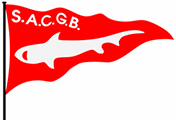Shark Fishing – Join Us!
The Shark Angling Club of Great Britain previously had a booking office in Looe where shark and other sea angling trips could be booked. This facility is no longer available.
Shark skippers across the UK normally deal with bookings direct over the telephone or via their website and Facebook pages.
Contact details for some Sharking Skippers are listed on our ‘Book a Day Shark Fishing’ page
Sharking trips in the UK generally take around 8 hours although longer trips can often be arranged. Some skippers work out of tidal ports and others from harbours so start times can vary. Most but not all skippers will supply rods and tackle if required so it pays to check before you arrive.
The day will usually start by trying to catch fresh bait. If not available most, but not all skippers will normally provide bait which has been caught previously.
Aside from bait an equally important element of sharking is rubby dubby. This is a mix of fish derivatives and is hung from the side of the boat to create a slick of fish oil and fish particles. The sharks superior sense of smell finds this slick and they follow the trail to the baits.
Rubby dubby is provided by some but not all skippers so it always pays to check this before booking.
Once the fishing grounds are reached the boat will drift, guided by the wind and tide. It is quite normal to drift for several miles during the trip.
Tackle will normally consist of a boat rod with a multiplier reel generally loaded with 300/400 yards line with a breaking strain around 50lbs although heavier gear is sometimes used. A wire trace with a baited size 10/0 or similar, circle or J hook suspended underneath a float completes the gear.
Most shark anglers prefer to use a fresh mackerel bait but sharks are caught on all fish baits. The baits are suspended at varying depths and allowed to drift away to different distances from the boat. The bait farthest away from the boat will normally be set the deepest and the one nearest will be the shallowest bait.
The baits sit inside the rubby dubby slick as this is where the sharks are attracted to. Contrary to widely held belief, sharks are wary and often before they take a bait they will have been observing it for some time.
Once the shark takes the bait it will move off causing the ratchet on the reel to sound. Strike techniques differ between J hooks and circle hooks and heeding the skippers advice dependent on the hook design you use is crucial.
Once the fish is hooked and played to the boat, the skipper will take hold of the wire leader and either release the fish in the water or bring it into the boat to unhook it. Once the skipper has hold of the wire leader it is classed as a “caught fish”.
Where sharks are brought aboard the boat, best practise is to have a door at the stern or side of the boat which opens just above the water level. This allows the fish to be slid into the boat and causes it minimum stress and damage. It is also best practise to have the deck surface wet and to dowse the fish with sea water whilst the hook is being removed. The SACGB do not support any form of body gaffing of sharks.
The SACGB have a strict policy of catch and release and all professional skippers and anglers adopt this practise. Many skippers and anglers assist with scientific research by engaging with shark tagging programmes.
